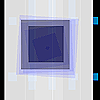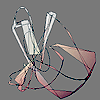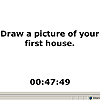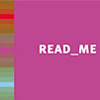 Evelyne
Rogue,
editor
of
Artcogitans.com,
examines
in
her
essay
Purblue
ou
le
bleu
dé-voilé
the
formal
qualities
of
Purblue,
an
online
project
by
Yan
Breuleux.
The
net
project
is
influenced
by
a
combination
of
emerging
technologies
and
paintings
by
abstract
expessionists,
particularly
Yves
Klein,
Barnett
Newman
and
Marc
Rothko.
Purblue
is
part
of
the
Flow/Courant
exhibition,
curated
by
Valerie
Lamontagne.
The
essay
is
written
in
French
and
appears
in
.pdf
format
(download
the
plug-in
if
necessary)
with
permission
by
Evelyne
Rogue.
Evelyne
Rogue,
editor
of
Artcogitans.com,
examines
in
her
essay
Purblue
ou
le
bleu
dé-voilé
the
formal
qualities
of
Purblue,
an
online
project
by
Yan
Breuleux.
The
net
project
is
influenced
by
a
combination
of
emerging
technologies
and
paintings
by
abstract
expessionists,
particularly
Yves
Klein,
Barnett
Newman
and
Marc
Rothko.
Purblue
is
part
of
the
Flow/Courant
exhibition,
curated
by
Valerie
Lamontagne.
The
essay
is
written
in
French
and
appears
in
.pdf
format
(download
the
plug-in
if
necessary)
with
permission
by
Evelyne
Rogue.
 Originally
published
on
10/01/03
Originally
published
on
10/01/03Short interview with Elout de Kok.
Elout de Kok lives and works in
Peter Luining: When did you start to create work for the Internet, and was there a specific reason for that?
Elout de Kok: Around 1993, I started uploading my interactive Amiga animations onto bulletin boards and dumping my ASCII-art on IRC. These days it feels good that I can express myself with graphics and code, and having a world-wide audience.
PL: A lot of your work looks inspired by 20's constructivism. Is this really the case or do you have different or other inspiration sources?
EK: I just started with these 'raw/simple' building materials; cubes and pixels, [also] inspired by Bauhaus/De Stijl/Constuctivism.
PL: You use different formats, like Flash, Java and C++ to make your work. Why?
EK: They all have their special pros and cons, and it's [a] good thing to learn different languages.
PL: These pros and cons of different languages I can understand, but isn't it so that if you learn one language, you can get much deeper into it?
EK: I slowly dig deeper into different languages now. And [the] reality/fear [is] in the back of my head that your work stops working if a big company decides not to support a certain OS, software or plug-in anymore.
PL: Recent works show a shift towards more personal work. Is this for a particular reason?
EK: I did some digital self-portraits back in 1993. One year ago, I rewrote one of them for the net, and it started from there.
PL: Could you tell something more about the why of this shift?
EK: Mmm. I didn't realize this shift. Maybe after all this playing, learning, and experimenting, I'm finding better ways to express myself; and IÕm trying to push this level every time.
Elout de Kok's site pixel-lab can be found at:
http://www.xs4all.nl/~elout.
:: Peter Luining ::
 Originally
published
on
09/25/03
Originally
published
on
09/25/03Recently exhibited as part of the Athica - Virtual Gallery v2, Brooke A. Knight's An Hour of Your Time is "An investigation of things you could be doing rather than watching this piece".
Literally taking, or using, an hour of your time, the piece gives suggestion after suggestion for each second of that hour, 3600 in total. An Hour of Your Time is surely a commentary into the social phenomenon that occurs with most web 'surfers:Õ pointless surfing through websites that are of no particular interest to fill the time. Beautifully simplistic, the piece turns an interactive format (Macromedia's Director) into a linear form, simultaneously progressing through time as we watch it count down backwards to
An Hour of Your Time is almost ambient as a net-art piece. Clean, simple, minimal, and unobtrusive, it focuses on a theme relevant to all 'surfers:' absence of time in virtual space undermined by time in the real world, which is represented by the system clock that keeps ticking forward or that dial-up connection timer that's just passed three hours. As for what happens at the deadline, the
:: Garrett Lynch ::
 Originally
published
on
09/25/03
Originally
published
on
09/25/03I was recently given a copy of Read_Me 2.3 Reader, a very simple and well designed book that offers writings on software art and its culture; many of the projects can be found at runme.org.
Read_Me 2.3 Reader offers a concise and intense set of interviews and reviews of artworks, as well as commentaries and reports. Some of the most compelling articles are in "Read_Me 2.3 Report," which explains the reasons behind developing Read_Me 2.3 Software Festival and " A Quick view at Software Art." The book also takes on emancipatory narratives in the interview of Hans Bernhard, "Bringing Capitalism and Democracy Closer Together." Unfortunately, many of the writings in the reader are not available online, except for the art reviews.
What is most interesting to me about this whole project is that it really comes to life through the printed material -- a book, which is the last thing one would equate with emerging technologies. Reading the text in such a traditional format is extremely welcomed, and (I will admit this is, perhaps, an idiosyncratic statement but) there is a sense of cohesion that I get from having the book around; being able to pick it up to read a section here and there. Read_Me 2.3 Reader is dense, informative, and unexpectedly abstract in thought, and it has a good chance of becoming the standard to better understand software art. Hopefully, it will be available at your local bookstore soon.
:: Eduardo Navas ::